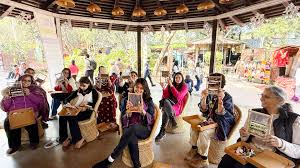
Menu

Sohrai and Khovar are two ancient mural art traditions of Jharkhand practiced predominantly by women in the Hazaribagh region. These arts are deeply tied to agrarian and marital rituals and are passed down through generations orally and practically.
Sohrai painting is done during the harvest festival and celebrates fertility and prosperity. The walls of homes are painted with images of animals like cows, elephants, and peacocks, symbolizing abundance. Natural earth colors like red, white, black, and yellow are applied with chewed twigs, broken combs, or fingers.
Khovar, on the other hand, is associated with weddings. Brides paint the marital chamber with designs signifying love and protection. These artworks are highly symbolic and abstract, featuring vines, flowers, and mythological figures.
Both styles use natural materials, including locally sourced clay and minerals, and are done on freshly plastered mud walls. The government and art activists, such as Bulu Imam, have played a vital role in bringing this rural art to national and international platforms.
